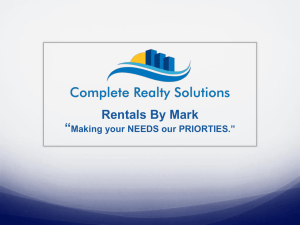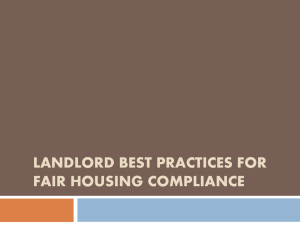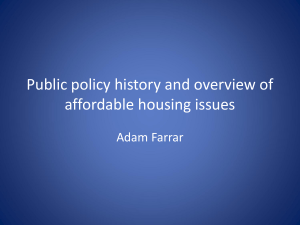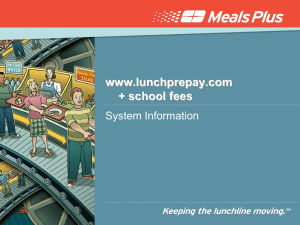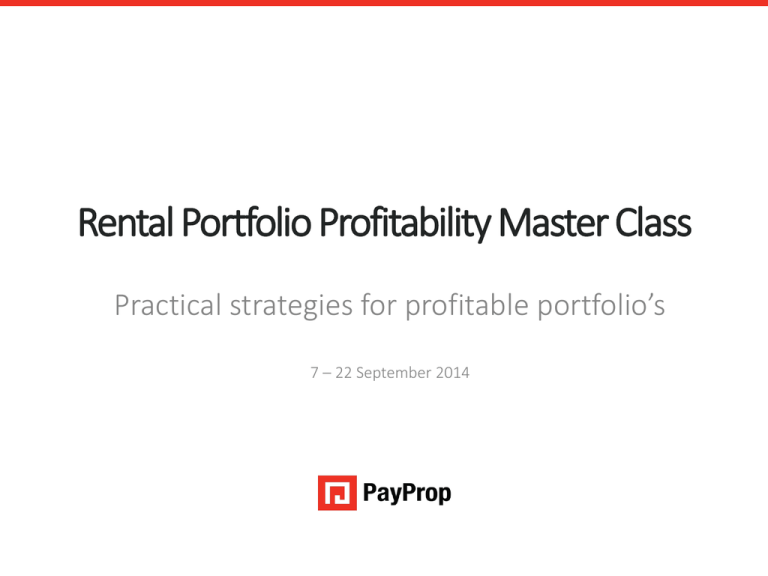
Rental Portfolio Profitability Master Class
Underwritten by RMB Structured Insurance Limited
Practical strategies for profitable portfolio’s
7 – 22 September 2014
An authorised financial services provider – FSP 43441
First, a note on CPD points
• 60 points need to be earned in a 3 year cycle (20 points per year)
• Points are split into 2 categories, namely verified and non-verified
• Currently the EAAB is the only body allowed to provide verified training
• Non-verified training has to conform to time and content requirements (duration & relevancy)
3 Year Cycle
(60 points)
Verified
Non-verified
(45 points)
(25 points)
Education and training
Professional development (max 5)
Corporate Social Investment (max 5)
Mentoring and coaching (max 5)
Reading and publishing (max 5)
Personal development (max 5)
And then a word on who we are
5
5
Our agenda for this morning
An authorised financial services provider – FSP 43441
The next few hours
09:00 – 09:30
PayProp State of the Rental Industry update
09:30 – 10:30
The rental portfolio business model
10:30 – 11:00
Tea Break
11:00 – 12:00
Valuation of a rental book
12:00 – 12:30
New in the industry
12:30 – 12:45
Summary & Closing
The State of the Rental Industry
Q2 2014
An authorised financial services provider – FSP 43441
Our predictions for the remainder of 2014
1. Average rental growth will settle in the 8% - 10% range
2. Consumer payment data will continue to deteriorate
3. Damage deposits will become un-affordable to tenants and deposit replacement products will
become more commonplace
4. Property investors will not see net yields of above 6% for some time
5. Watch the Northern Cape!
Average rentals break the R6 000 barrier
Weighted average national rental
6200
6100
6000
5900
5800
5700
5600
5500
5400
• Current weighted average rental in South Africa is R6 144
Growth has stabilised
Year-on-year percentage change in rentals
12.0%
10.0%
8.0%
6.0%
4.0%
2.0%
0.0%
• Growth rates are slowing down after having hit a high of 10.8% in October 2013
• Current year-on-year growth rate is 8.9% and we expect it to stay there for some time
Limpopo normalises
Provincial average rentals
Limpopo
7152
Mpumalanga
6726
Northern Cape
6398
KZN
• Mpumalanga continues with stable
growth
6256
Western Cape
6158
Gauteng
6045
Eastern Cape
4829
Free State
4592
North West
4528
0
1000
2000
3000
4000
5000
• Eastern Cape has an impressive
recovery
6000
7000
8000
• Northern Cape is the new emerging
start
Provincial growth rates
20.0%
18.0%
16.0%
14.0%
12.0%
10.0%
8.0%
6.0%
4.0%
2.0%
0.0%
• Limpopo is starting to slow down
• Freestate continues to struggle
• Western Cape, KZN and Gauteng
continue to experience stable growth
Eastern
Cape
Free
State
Gauteng
KZN
Limpopo
Mpumal
anga
North
West
Norther Western
n Cape
Cape
Q3 - 2013
7.4%
5.7%
8.9%
11.7%
10.6%
7.0%
7.7%
18.4%
10.2%
Q4 - 2013
11.4%
6.7%
12.7%
7.7%
3.5%
8.7%
7.8%
14.8%
9.5%
Q1 - 2014
10.7%
5.7%
10.5%
7.5%
4.4%
7.2%
7.0%
12.6%
9.4%
Q2 - 2014
8.6%
3.7%
6.3%
8.1%
2.4%
2.4%
4.6%
13.1%
10.3%
• Very little movement in the North
West
Damage deposit ratios stabilise
National damage deposit ratio
1.36
1.34
1.32
1.30
1.28
1.26
1.24
1.22
1.20
• Stabilisation in damage deposit ratio
• Currently at 1.34
• It seems that there is a limit to what tenants can afford
• Growth of deposit replacement products
Low, but stable investor returns
National Gross and Net Yields
8.00%
7.18%
7.08%
7.12%
5.13%
5.15%
4.92%
4.74%
2013 Q1
2013 Q2
2013 Q3
7.21%
7.00%
6.00%
5.00%
4.00%
3.00%
2.00%
1.00%
0.00%
National Gross Yield
2014 Q2
National Net Yield
• Both net and gross yields remain stable – despite rental growth
• Consummate increase in property values neutralise gross yield gains
• Consummate increase in cost of ownership neutralises net yield gains
• Remember that the yield calculation does not take capital growth into account – if that is added
in, it increases to 12.81%
• Rental yields therefore only cover the cost of ownership and investment opportunity costs
‘Counter-intuitive’ provinces lead the pack
Provincial net yields
8.00%
7.00%
6.00%
5.00%
4.00%
3.00%
2.00%
1.00%
0.00%
Eastern Cape
Free State
Gauteng
KZN
Limpopo
Mpumalanga
North West
Northern Cape Western Cape
2013 Q3
4.95%
4.66%
4.70%
5.47%
7.48%
6.80%
4.71%
6.06%
4.44%
2013 Q4
4.83%
4.62%
4.80%
5.36%
7.44%
6.75%
4.72%
6.58%
4.48%
2014 Q1
4.79%
4.29%
4.61%
4.92%
7.35%
6.47%
4.85%
5.59%
4.22%
2014 Q2
4.54%
4.22%
4.42%
4.70%
7.27%
6.37%
4.78%
5.11%
4.05%
• Northern Cape, Limpopo and Mpumalanga offer the best returns for investors
• High cost of ownership in the Western Cape and Gauteng limit what investors are able to take
home
Agents defend their commissions
National average commission
10.40%
10.30%
10.20%
10.10%
10.00%
9.90%
9.80%
9.70%
• Agents seem to have taken a deliberate decision to defend their commissions
• There was a time that the data showed a declining trend, similar to that of sales commissions
• However, we are increasingly hearing of non-metro commissions being under increasing pressure
Our first lesson on profitability
•
You will only do well, if your landlord does well
•
Current national average cost of ownership sits at 33% and is increasing
• Agent commissions
• Rates & taxes
• Repairs
National cost of ownership
34%
33%
32%
31%
30%
29%
28%
27%
26%
25%
Cost of ownership
•
•
Q2 2013
Q3 2013
Q4 2013
Q1 2014
Q2 2014
29%
29%
28%
31%
33%
That means that on an average rental of R6 144, a owner only takes home R4 116
There is little room for error in making sure that your landlord is happy
The rental business model
An authorised financial services provider – FSP 43441
Basic assumptions
•
We built the model based on a set of assumptions developed through our exposure to hundreds
of rental portfolios
•
The model is meant to help test some of the most important assumptions the owner of a rental
business faces
•
It is not meant to provide definitive answers, but to help you stress test different scenario’s for
your business
•
A model like this should not be viewed as investment advice, but merely one of a series of tools
that you could use to better understand a business
•
We will e-mail all attendees the model tomorrow
•
You cannot break it – so feel free to play with it
•
However, you also cannot edit detailed assumptions
Let’s define average
This is the typical rental portfolio that we come across (and that we have used for modelling)
• 100 properties with 10% managed commission
• No real introduction rentals
• 98% collections each month
• 1 Admin and 1 agent
• Admin on fixed R7 500 and agent on 50% commission split
• Charging lease fees, and little else
Results-wise, this agency produces
• R60 211 in commission each month
• Retains R31 473 as profit (48%)
• That is R3 800 profit per property per year
The first, most basic income principle
Tenants vs paying tenants
• According to the latest TPN report 6% of tenants are not paying rent
• You can legally only take your commission once the rent is received – so without rent you
have no commission
• On a typical portfolio, you make an additional R350 net profit for each percentage point in
collection improvement
• The difference between the industry norm of 94% and the 100% collection is just over R25
000 per year
• This does not begin to include the cost, time and effort of dealing with a non-paying tenant
How to increase collections
• Better tenant selection
• Early detection
• Credible threat
• Rental/deposit guarantee products
And what if they don’t pay?
Debt collection fees
• There are legislated fees up to a maximum of R841
• R17 per fax, email, phone call, letter, “necessary expenses”
• R2.20 per SMS
• R166 for serving physical documents
• R33 for drawing up settlement accounts
• R41 per consultation
• R8 for correspondence received
•
You can only charge these fees if you are a registered debt collector
Late payment penalties
• Some leases make provision for the use of a ‘late payment penalty’ if the tenant does not
pay
• Take note that this is interpreted differently in different provinces – in Gauteng it is illegal
and in the Western Cape it is not
• Understand why you are charging this fee (and explain it accordingly)
• Is it to compensate you for reasonable costs of collection?
• Is it to compensate the owner for lost interest
• Do not confuse why you are collecting with who you are collecting for!
Other income variables to consider
Transaction fees and tenant admin fees
• Tenants have a number of payment channel choices, some which are cheaper than others
• Depending on the conditions of your lease, you may be able to recover some of these costs
• Don’t limit your options by only stating ‘cash deposit fees’ as this is an area of growing
diversity (rather use “transaction fees” as a descriptor)
Sources of incoming funds
ATM, 5.80%
Average transaction charges
Rest, 6%
Cash Deposit,
13%
Debit Order,
8.70%
EFT, 63%
Retail store
payments,
3.80%
Banking Fee Comparison
Account Fee
EFT's
Debit Orders
SMS's
Email's
Fixed Cash Deposit
Cash Deposit %
R
R
R
R
R
R
Average
51.88
7.60
8.60
0.79
0.66
6.78
1.22%
Recovering transaction fees
•
Just recovering cash deposit fees equates R873 per month in additional net income for your
business
•
However, per tenant recovery can be cumbersome and some agencies are resorting to a
fixed ‘tenant admin’ fee that spreads total bank fees across the entire tenant pool
•
As long as it is in the lease and the tenant explicitly agrees to the cost, either route is
feasible
Some income variables to consider
Credit check fee
• Credit check costs can vary from R68 – R138 per check
• In many cases it takes up to 5 checks to find an appropriate tenant, and you are bearing the
cost of this each time
• With the escalation in these fees, many agencies are asking an up front application fee
• In a typical agency, a R100 per check recovery adds R10 800 per year to the bottom line
• Refunding successful tenants drops this saving to R7 200
Lease fee
• Traditionally charged because lawyers were used to set up legal agreements, but the
availability of specialised (and free) contracts has reduced the need to do this
• Accordingly this is pure profit and at around R750 a time adds almost R4 500 to the profit
pool
• On introduction rentals the result is even greater
• However, section (p) was added into the Rental Housing Amendment Act in 2008
“any costs in relation to contract of lease shall only be payable by the tenant upon proof of
factual expenditure by the landlord”
Some income variables to consider
•
Damage deposit management fee
• The Estate Agency Affairs Act and EEAB guidelines state that you can keep the interest on a
deposit only if you have clearly informed the tenant of the interest and your intention to
keep it
• If you retain interest, you have to pay 50% over to the EAAB
• However, the law does not prohibit you from charging an administrative fee for managing
the deposit
• Your fee is justifiable as you incur transaction, service, audit and direct administrative costs
in keeping the money
• Administrative fees don’t have to be shared the same way as interest retained
• In determining what is a feasible charge, consider the interest that an average deposit earns
• The average damage deposit is R7 930 (1.3 x rental)
• 5% interest rate earns it R371 per year in interest
• 1% interest rate earns it R75 per year in interest
• It would be grossly unfair to the tenant (and the landlord) to charge more than the
interest earned
Checking the boxes
• Remember that you cannot levy any charges that are not explicitly agreed to in the lease
• Be upfront with landlord on additional charges you levy
• Ensure that you provide a post-payout breakdown of all deductions
Procurement vs managed rentals
•
•
•
•
Typically procurement rentals attract a lower commission (7.5%)
Interestingly, not really dissimilar from a margin % perspective
However, on actual cash contribution to the business, managed rentals deliver double the income
Managed rentals
Monthly income per property
Monthy expenses per property
Annual once-off income per property
Annual once-off expenses per property
Total profit per property per year
Net Margin %
R
R
R
R
R
614
374
750
135
3 497
43%
Procurement rentals
Income per property
Expenses per property
Total profit per proptery per year
Net Margin %
R
R
R
3 686
2 088
1 599
43%
Other reasons why we believe that managed rentals are a smarter option
• You stay closer to the owner and more likely to get the renewal
• You are closer to being the effective cause of a sale
And this is what the sandbox looks like
•
In the model we have provided you with an ‘Income Variables’ play-space where you can adjust
the different variables to see what effect it is likely to have on your income
•
By just adjusting some of the basic variables (transaction fee recovery, lease admin fee, credit
check fee), we were able to show R3 500 pm more in profit
That’s more than R40 000 per year
•
Some expense variables to consider
Manual vs automation
• When starting a portfolio this is of minor concern – the average ‘manual capability’ seems
to be in the region of 50 properties
• Not investing in automation is a self-limiting and expensive decision when you are trying to
grow
Effect of automation
R 120,000
90%
R 100,000
70%
R 80,000
50%
R 60,000
30%
R 40,000
10%
R 20,000
-10%
R-
-30%
10
25
50
75
100
150
200
R -20,000
250
-50%
Net profit with PayProp
Net profit without PayProp
Net profit % with PayProp
Net profit % without PayProp
Some expense variables to consider
Bank fees
• A ‘rule of thumb’ is that bank fees generally equate to 0.5% of turnover
• PayProp saves you at least 30% on published bank rates
• Use batch-remittance fees as far as possible
Credit check costs
• Watch this space…
Accounting
• You are required, by law, to reconcile your trust account every month
• Time estimate is 1hr for every 25 properties
• Cost estimate is between R350 – R450 per hour
• That’s around R1 350 per month just to reconcile a 75 property portfolio’s trust account
• Just having ‘a system’ does not absolve you from this responsibility
Employment structure considerations
•
Basic role differentiation
• Growth and maintenance
• Typically we find that without automation a single administrator can manage 50-75
properties
• We find that mostly there is a evolution of staffing in a typical agency, namely me; me +
part-time admin; me + full-time admin; full-time admin + agent
• It is important to consider your growth horizon when you make remuneration decisions
early on, for example:
• Sharing commission from day 1 when you have 5 properties, means that you will
be sharing commission when you have 100 properties
•
The various means to pay and their relative benefits
• Fixed salary
• Lease fee split
• Managed lease commission
• Procurement lease commission
•
The cost associated with commission generation
• Bank costs
• System costs (i.e. PayProp) and how to adjust for them
And this is what the sandbox looks like
Other issues to take into account
•
Money is not only a means of reward of services done, but is also a powerful motivator
•
Understand the type of behaviour that you would like to see in your business, for example
• Motivating administrative staff on retention of the existing book
• Motivating agents on constant flow of new deals
•
Some things to watch for…
• “Nest building’
• Unintended behaviours
• Reasonableness of income generated
Finally, a thought on growth
•
Economies of scale work up to a point, then your business settles at a stable margin %
•
At below 50 properties, you are still absorbing a lot of fixed costs
Valuing a rental portfolio
An authorised financial services provider – FSP 43441
Main schools of thought
Net Present Value (NPV) Method
• The basic principle: R1 today is worth more than R1 next year
• Cash flows are projected forward, and discounted back to today’s value
• Risk factors are taken into account when determining a discount factor
• You are paying for the current value of all future cash-flows
Earnings Multiple Method
• The basic principle: How many months is it going to take for this business to pay for itself
• Typically expressed in number of months that relate to net profit earned
• I.e. 30 times earning multiple = 30 times average monthly net income
Practical Method
• A business is only worth as much as a seller is prepared to pay for it
The same rules apply when using this model
•
We built the model based on a set of assumptions developed through our exposure to hundreds
of rental portfolios
•
The model is meant to help test some of the most important assumptions the owner of a rental
business faces
•
It is not meant to provide definitive answers, but to help you stress test different scenario’s for
your business
•
A model like this should not be viewed as investment advice, but merely one of a series of tools
that you could use to better understand a business
•
We will e-mail all attendees the model tomorrow
•
You cannot break it – so feel free to play with it
•
However, you also cannot edit detailed assumptions
The most important variables to consider
Investment horizon
• How far are you prepared to look forward
• How far can you look back to confirm the trend
Realism of earnings assumptions
• How do I interrogate the assumptions given (especially when they look forward)
• Is the infrastructure in place to support the projections?
Assessment of risk – what to look for
• Staff turnover
• Remuneration package effects (look at all contracts)
• Landlord mandate losses
• Deposit risk (is it all there?)
• Regulatory compliance
• Reputational standing
Practical considerations
•
What is the current financial status of the business?
• Is there pending legal action?
• Are there major debtors?
•
Advertising the sale to potential creditors
• See section 34 of the Insolvency Act (1, 2 &3)
•
What legal agreements are in play?
•
Are you legally allowed to buy this business?
• Are you an estate agent?
• What is their standing with the EAAB?
• Grey area of FFC renting
What am I buying?
Two main considerations:
1. The legal entity
• Risks
• You assume all debts and obligations
• Benefits
• Easy transition
2. The contracts of the entity
• Risks
• You have may loose a lot of what you have bought
• Benefits
• You know nothing is going to come out of the woodwork
Structuring the deal
1. Full cash-up front
• Once-off transaction
• Clean split
• But what if worms come out of the woodwork….
2. Share purchase with earn-out
• Buy a share now – and I pay for the rest with earnings from the business
• Give your share of the earnings each month to buy back more shares until you own them all
• The better the seller does in the transition, the quicker he gets his mone
• Risk: loss of interest after having sold
3. Deposit + repayment plan
• Helps if you don’t have al the cash now
• Be prepared to pay slightly more
• Consider the claw back
4. Escrow -based release plan
• Give all the money to the lawyers
• Release on the achievement of key milestones
• i.e. reconciliation of deposit account
• Meeting of budgeted turnovers
So what are the general trends?
•
With the regulatory compliance burden growing, we have seen an increase in the rate of portfolio
acquisition
•
Typically it is rare to take a view of more than 3 years on a rental book – and most at a NPV level
gravitate to a two year view at medium to high risk
•
This usually equates to around an 18 x monthly earnings multiple
•
Interestingly, at these levels, the valuation is not far of the ‘rule of thumb’ of one month’s
turnover
•
We have seen a few instances where, despite the valuation work being very well done, that the
deal structure turned everything into a mess
New stuff!
An authorised financial services provider – FSP 43441
We’ve summarised our previous learnings…
•
Go to the events page on PayProp
•
Select Rental Industry Session #4
•
Click on “five things we’ve learnt from the conference”
•
Enjoy
So we released some leases…
•
Thanks for the feedback
•
Changes made
•
How to get them
And we are about to make you feel safer…
•
Beneficiary validation available at the end of September 2014
•
Cost R3.80 per validation
•
Confirms identity and bank accounts match at the bank
And then you asked about tenant assessment…
•
Colin Habberton: PayProp Capital: CEO
Understanding Tenant Risk
In the May Masterclass we covered the following points:
• What are the risks and how can they be mitigated?
• Explain the importance of tenant assessment and some tools
• What to look out for - contracting party vs. the tenant – identity fraud
• The purpose of using credit history in evaluating tenant risk
• The requirement for consent - the relevance of the POPI Act
• Knowing how to use credit reports – the basics
• What can be buried in the detail - number of accounts, recent checks
• How are these reports are compiled - credit bureaux and the CPA
• Why tenants can be declined - case study: DepositGuarantee rules
So what is our experience?
Tenant Eligibility
80%
70%
60%
50%
40%
30%
20%
10%
0%
DepositGuarantee
•
On average between 60-70% of tenant applicants are ineligible
•
Using a firm but fair set of rules to assess total rental and indemnity exposure
•
Differences between our results and their current reports – affordability checks
How does that leave you feeling?
Introducing more than just a credit check…
Assessment of Tenant Risk
Elements of the Report
• Identity Verification
• Fraud Check
• Delinquency Report
• Credit Behaviour
• Indebtedness
• Affordability
• Rental Risk Matrix
• Eligibility for DepositGuarantee
• Detailed Underlying Data
Format of the Report
Decision-making tools
• Graphic representations
• Indicators & Icons
• Comfort level categories
Rental Risk Matrix
Summary ‘Heat Map’
Underlying Components
• Arrears, Timespan, Indebtedness & Affordability Algorithms
The Report Itself
Summary Results
• Identity Verification
• Personal Information
• Financial Profile Analysis
• Clear, concise explanations
• 11 Pages in total
The Report Itself
Detailed Analysis & Commentary
The Report Itself
Detailed Analysis & Commentary
The Report Itself
Immediate DepositGuarantee Elgibility Results & Extra Benefit
Compuscan Partnership
1 of the big 4 Credit Bureaux in SA
• In operation since 1994
• 20 million credit records
• 150 million accounts
• Credit data provider
• Source data included
Availability & Cost?
A Final Word: The Importance of Consent
Protection of Personal Information Act (POPI):
• Covers information relating to clients, suppliers, employees, persons receiving
marketing information, persons present on premises etc.
• All personal information which is protected incl.: race, gender, sex, marital status,
sexual orientation, age, physical/mental health, religion, criminal and financial
records.
• Sources of information impacted include payroll data, CVs, employment
applications, HR & security records, standard information, even internal emails.
• Existing manuals created in terms of the Promotion of Access to Information Act
which spell out the company’s policy must be updated in line with PoPI.
• Explicit permission needs to be given for collection and use before data is
collected.
• Data can only be collected from public domain; no more rented database lists
• Companies will also need to motivate why they need to keep certain data.
• Individuals need to be informed for how long information will be kept.
(Institute of Directors SA, 2014)
We hope that leaves you feeling more…
Thank You!
• We welcome your feedback
• See you again in Q2 of 2015


